![]() In the 1970s, classroom and pool training for the typical beginning scuba course met twice a week for from four to five weeks, providing a minimum of at least 30 contact hours. By the 1980s, this was generally down to twice a week for two to three weeks, providing less than 20 contact hours.
In the 1970s, classroom and pool training for the typical beginning scuba course met twice a week for from four to five weeks, providing a minimum of at least 30 contact hours. By the 1980s, this was generally down to twice a week for two to three weeks, providing less than 20 contact hours.
Today, the most popular format for entry-level training is a weekend of classroom/pool training, followed by a weekend of open-water dives. Total contact hours for classroom and pool seldom exceeds 15; actual confined water time is generally six hours or less.
Bear in mind, none of this change was due to dive instructors’ desire to cut corners or make their jobs easier. As a generalization, most dive instructors would prefer to spend more time with students, not less. The problem is that today’s consumers are unwilling to invest the time they once did in learning to dive.
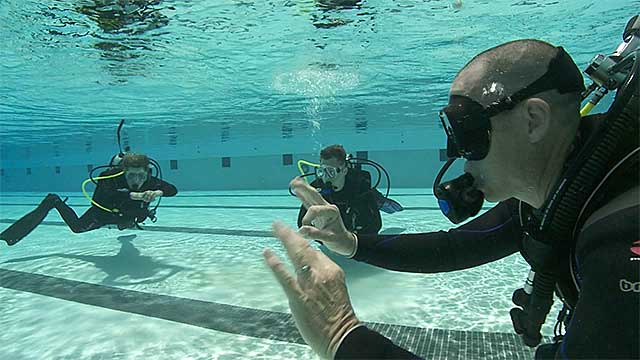
The good news is that it is technically possible to adequately prepare many, if not most students for open water in such a compressed time frame, provided instructors use time effectively. What is not realistic is to assume that every student who participates in such accelerated training can adequately prepare for open water in such a limited time span.
Unfortunately, while modern dive instructor training generally provides instructor candidates with ways to assess whether or not students have adequately mastered individual skills, it seldom provides guidance on how to assess whether students’ overall competency is such that they are ready to progress to the next level.
The following video shows ten things, any of which are strong indicators that students need more time in confined water before being allowed to take part in open-water training. Some of these things reflect shortcomings on the part of individual students. Others reflect failings on the part of the instructor — often because the instructor’s training agency failed to provide adequate guidance.
Regardless of who is to blame, all of these are problems that need to be corrected before students take part in open-water training dives — and long before they are actually certified.
Let’s look at each of these ten things in greater detail.
1. They can’t clear a mask without significant stress
It should go without saying that no student should be allowed to progress to open water until he or she can perform all core skills (regulator recovery/clearing, mask clearing/no-mask breathing and gas sharing) without significant difficulty and without undue stress. This is especially true of mask clearing. Why?
A student who panics while clearing a mask in the shallow end of the pool may bolt to the surface — but will not likely be injured. In contrast, a student who panics while attempting a mask clear in 6 m/20 ft or more of open water may be lucky if all that happens is that he or she bolts to the surface. Under these circumstances, there is a very real possibility the student may embolize or drown.
Worse, if a student gets certified before becoming comfortable with mask clearing, that panic may come when his or her mask floods in substantially deeper water. Either way, your position as an instructor is utterly indefensible.
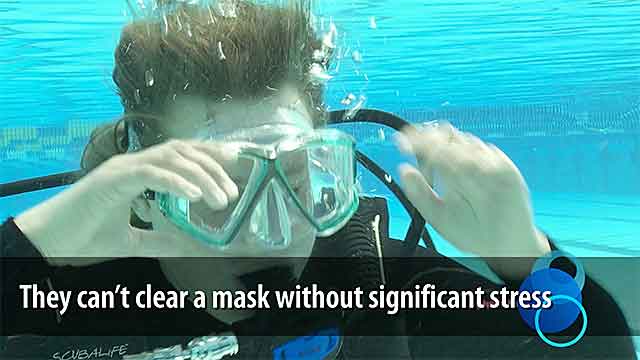
There is a tendency among many dive instructors to reward effort instead of actual accomplishment. In other words, so long as a student makes repeated attempts at mask clearing, marginal performance may be deemed acceptable. This is a very understandable emotion — but one you can’t afford to fall victim to.
If you truly care about your students, put their safety first. Mask clearing may never be your students’ favorite skill, but it needs to be one they can do without undue stress prior to ever being allowed to progress to open water.
2. They can’t do a proper kick
A bicycle kick may be funny to watch, but it’s no laughing matter. Divers who cannot move through the water efficiently:
- May be left behind by inattentive buddies or exhaust themselves trying to keep up.
- May be swept away by waves or current.
- May damage coral and other fragile aquatic life.
- May stir up silt, ruining visibility for themselves and others.
- Are not likely to have a lot of fun.
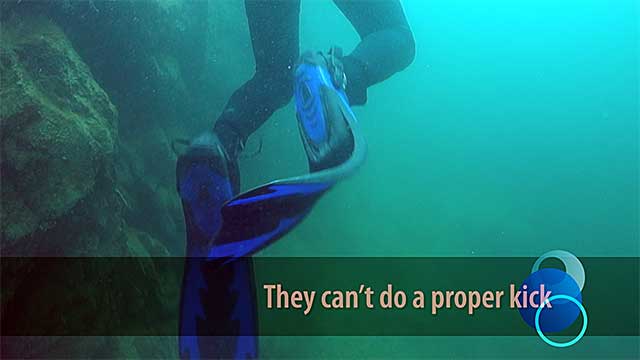
Your entry-level students may not be the world’s strongest swimmers. Nevertheless, they should have no difficulty demonstrating at least a moderately effective flutter, modified flutter or frog kick. Until they can, they need to stay in confined water.
3. They think 20 pounds is okay with a 3 mm suit
Most students just wear however much weight their instructor gives them — which is generally way too much. About all students seem to remember about proper weighting is something about “floating at eye level” which, if you truly understand buoyancy control, you know is often utter nonsense.
Just about any dive boat captain can tell you story after story of divers who show up wearing skins or shorties, yet insist they need 20 pounds or more of lead. This is not just wrong, it’s dangerous.
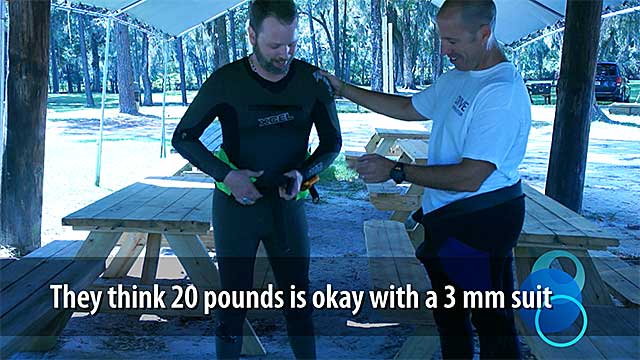
Before being certified (and, in fact, long before progressing to open water), students need a clear understanding that:
- Buoyancy control is more about proper weighting than it is about pushing buttons on a BC.
- As divers, their goal should always be to wear the least weight possible.
- In confined water, they should never wear any more weight than is necessary to achieve perfect neutral buoyancy in shallow water with no air in their BCs.
Many instructor candidates are told by their instructor trainers and, sometimes, even by the training agency itself, that students should be weighted in confined water so that they cannot “escape to the surface.”
This is actually among the worst advice any new instructor can get. Allowing students to get in the habit of diving overweighted is not only dangerous, it’s environmentally irresponsible.
Students need to take an active role in experimenting to find out how much weight to wear. They need to know exactly how much weight they are wearing at any time, and how factors such as salt water and thicker exposure suits will affect this. They also need to know that you will hold them personally responsible if they are overweighted.
Forget the “float at eye level” nonsense. It’s simply not applicable in shallow water with thin exposure suits. Strive instead for students being able to maintain neutral buoyancy in the shallow end with no air in their BCs, and in the deeper end with just minimal air in their BC air cells.
Make sure students understand that, until they can correctly determine the right amount of weight to wear, on their own, no one is going to open water, and no one is getting certified.
4. They go vertical as soon as they stop swimming
“Dive like a fish and not like a bottom-dwelling slug.” How often to you see fish:
- Stand on their tails?
- Walk on their tails?
- Stand, sit or kneel on the bottom?
The answer: Never. Fish are almost always horizontal and your students need to understand that, unless ascending or descending, they need to be horizontal as well.

If your students are properly weighted, they have the right amount of air in their BCs and they are in balanced equipment, all that should happen when they stop swimming is that they remain horizontal. If students do not, not only are they not ready for certification, they are not ready for open water.
5. They think it’s okay not to clip off octos and consoles
As an instructor, it’s your responsibility to ensure your rental/teaching regulators are equipped with hardware that enables octopuses and consoles to be clipped off so that they dangle no more than a hand’s width below each student.

It’s your students’ responsibility to make sure this hardware is used at all times. If they do not, they are not ready for open water and not ready to be certified.
6-7. They still stand, sit or kneel on the bottom
Consider the irony:
- Show the average dive instructor a picture of a certified diver with his mask on his forehead. Odds are, the instructor will say, “I’d never allow my students to develop that habit…”
- Show the same instructor a picture of divers leaving tanks standing unattended. The instructor will say, “That’s something I won’t tolerate…”
- Show the instructor a picture of divers standing on coral, kneeling on fragile aquatic plants or sitting on a sea turtle, and the instructor will say, “Those are horrible habits! I’d never allow my students to stand, sit or kneel on the bottom…oh, crap, I do it all the time…”
Masks on foreheads and tanks standing unattended are, in fact, poor habits for any diver to develop. Their severity, however, pales in comparison to the environmental destruction that can be caused by students who get in the habit of being in constant contact with the bottom.
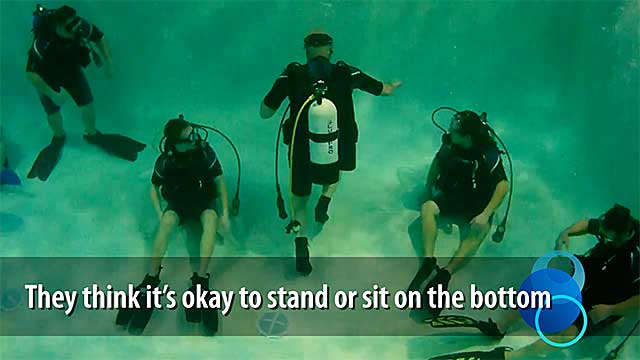
Remember: It’s always easier to form good habits that it is to break bad ones. Let students know that, unless they can demonstrate good buoyancy control habits by minimizing or avoiding contact with the bottom, they are not going to open water.
8. They can’t get neutral without doing a “fin pivot”
When you think about it, “fin pivots” are about the Worst Skill Ever.
- To start, they only work in shallow water if students are overweighted and in out-of-balance equipment (i.e., equipment that makes their feet sink). With the right gear and the right amount of weight, your students won’t be able to do fin pivots — they’ll simply hover, horizontal, over the bottom with no air in their BCs.
- Second, fin pivots convey the wrong message. That is, that buoyancy control is all about pushing buttons on a BC, rather than a combination of proper weighting, breath control, balanced equipment and only enough air in a BC air cell as is needed to compensate for exposure suit compression.
- Third, they’re unnecessary. If your students are properly weighted, they’ll need to add so little air to their BCs when venturing into slightly deeper water (think deep end of the pool) that they can figure this out on their own, with just a little guidance from you.
More important than doing anything remotely like a fin pivot is teaching students how to effectively position their bodies so that either the BC hose elbow, remote exhaust or manual dump valve is at the highest point when divers are in a normal swimming position. Have students practice this several times by adding a small burst of air to their BCs in shallow water, then immediately venting it.
Remind students that, when they venture into the deep end, they will likely need to add a small burst of air to their BCs to maintain neutral buoyancy — but that they will need to vent this air when returning to shallow water. Have students do several circuits into and out of deeper water until this becomes second nature.
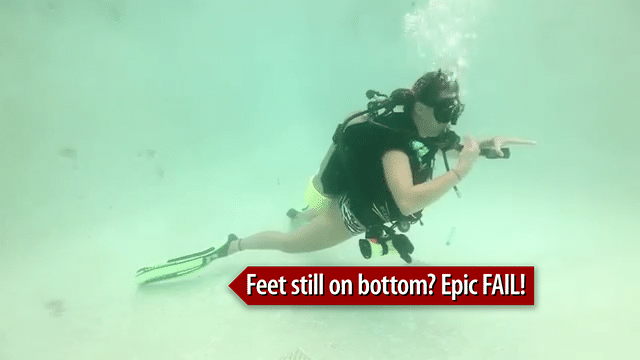
Above all, let students know that, if you catch them doing anything like a fin pivot, they won’t be going to open water until they can break that habit in favor of maintaining neutral buoyancy at all times.
9. They can only hover while sitting like Buddha
Seriously, how often in the real world do you see divers hovering like Buddha? The Buddha hover was invented in response to the fact most students learn in equipment that is so hideously out of balance their feet can’t do anything but sink. It’s unrealistic — and totally unnecessary.
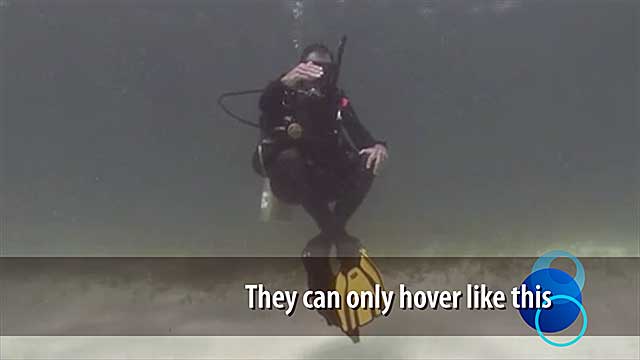
A real-life hover is what should happen when students are properly weighted, in balanced equipment and have only as much air as is needed to offset exposure suit compression in their BCs…and they simply stop kicking. This is something that should happen frequently throughout the course.
Students whose buoyancy is not under control frequently plane — that is, swim with their fins at a downward angle to generate the lift needed to stay off the bottom.
You can help break them of this habit by having them stop frequently while swimming. when they do so, they should simply hover while maintaining horizontal trim. If they can’t:
- They most likely need less weight.
- They may also need more practice adding air to their BCs in response to suit compression.
In any event, a student who can only hover while in the Buddha position has got some serious problems to solve before being ready for open water.
10. Buoyancy Control Turtle disapproves of their flailing
Make sure this image is burned into students’ minds. Until their skills meet Buoyancy Control Turtles’ approval, no one goes to open water and no one get certified. Period.

During your pre-course orientation, it’s important you make clear to students that merely taking part in your scuba course is no guarantee they will complete the process in any given time frame. Treat open-water training as a privilege — one students can only earn through adequate performance.
Make certain students clearly understand this and most will pleasantly surprise you.
